Home Decor & Design
Indonesian Textile Patterns That Will Take Your Home From Drab to Fab
Join the journey of transforming your home with stunning Indonesian textile patterns that promise to inspire your decor—discover the magic within!
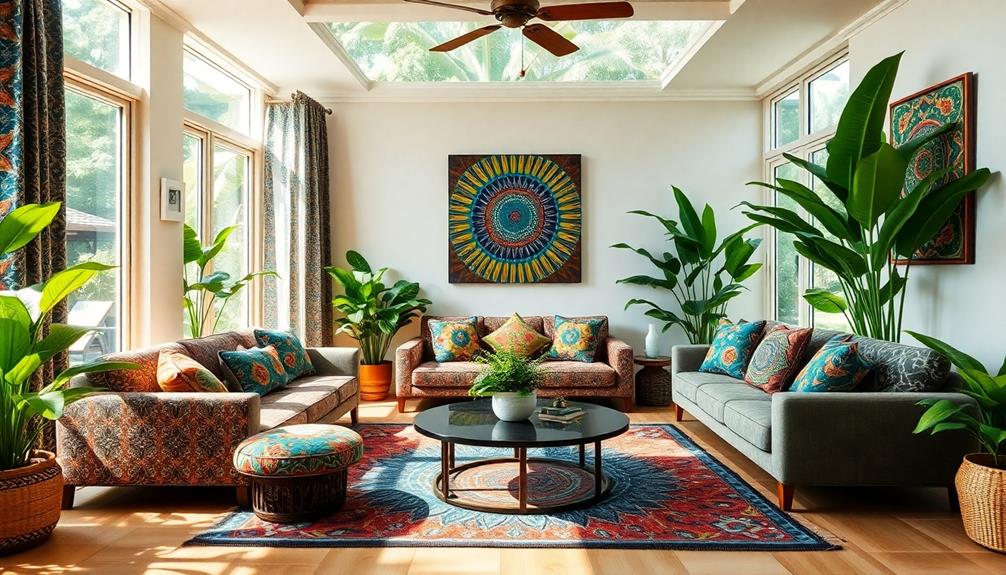
Indonesian textile patterns, especially batik, can completely elevate your home's vibe from drab to fab. These intricate designs and vibrant colors bring warmth and cultural flair to any space. You can use batik fabric for statement wall art, stylish cushion covers, or elegant table runners that cook up an inviting dining atmosphere. Plus, incorporating unique batik accessories, like coasters and trays, can add that extra touch of sophistication. Not only will you support local artisans, but you'll also embrace sustainable crafting practices. Discover how you can release creativity with batik patterns and transform your living space beautifully.
Key Takeaways
- Incorporate batik fabric into home decor through framed wall art, adding cultural flair and vibrancy to any room.
- Use batik cushion covers to transform plain cushions into stylish accents, enhancing comfort and aesthetic appeal.
- Elevate dining experiences with batik table runners and placemats that combine elegance with durability for a cohesive look.
- Create unique DIY projects using batik, such as coasters and trays, promoting creativity while embracing traditional craftsmanship.
- Choose batik accessories like coasters and trays to protect surfaces while celebrating Indonesian artistry in your home.
Exploring Batik Heritage
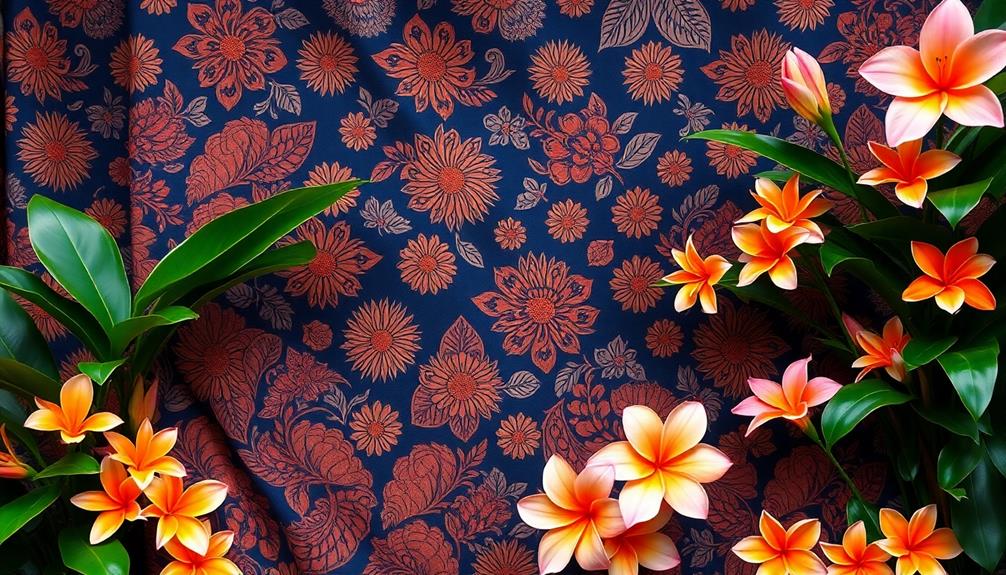
Have you ever wondered how batik captures the essence of Indonesian culture? This traditional textile art form, recognized by UNESCO as an Intangible Cultural Heritage, showcases intricate patterns onto fabric that reflect the rich cultural identity of Indonesia. The term "batik" itself comes from Javanese words meaning "to write" and "dot," highlighting its historical roots in writing patterns onto fabric through a meticulous wax-resist dyeing technique. Face Indonesian Decor Mask and other cultural crafts exemplify the artistic expressions tied to this heritage.
Each design tells a story, often conveying social status; certain patterns were historically reserved for royalty, symbolizing the artistry and cultural significance tied to Indonesian heritage.
As you explore Indonesian Batik, you'll discover two main techniques: batik tulis, which involves hand-drawn wax application, and batik cap, using stamped copper blocks for mass production. Both methods require skilled artisans who dedicate their craft to preserving this vibrant tradition.
The intricate process of creating batik involves multiple stages of dyeing and waxing. The complexity of the designs not only showcases higher craftsmanship but also deepens the cultural relevance of each piece within Indonesian society.
Transformative DIY Projects

Transforming your living space with Indonesian batik can be an exciting and rewarding experience. You can start by creating stunning DIY batik wall art. Frame pieces of batik fabric or mix various batik patterns to add a touch of cultural flair to your walls.
For a playful twist, sew batik fabric covers for your plain cushions, turning them into vibrant decorative accents that enhance both comfort and aesthetics. Incorporating vibrant colors and intricate patterns from Indonesian textiles can elevate the overall ambiance of your home.
Don't forget about your dining area! Elevate your dining experience by using batik cloth as table runners or placemats. This adds elegance and creates a cohesive look that pairs beautifully with your dinnerware.
Additionally, explore the world of functional accessories by designing coasters, trays, and storage boxes. You can use decoupage techniques to showcase these batik-inspired pieces while promoting sustainable crafting practices.
Engaging in these hands-on DIY projects allows you to express your creativity and personalize your home decor. Plus, you'll embrace the traditional craftsmanship of Indonesian batik, making your space uniquely yours.
With just a few simple projects, you'll transform your home from drab to fab!
Batik in Home Decor
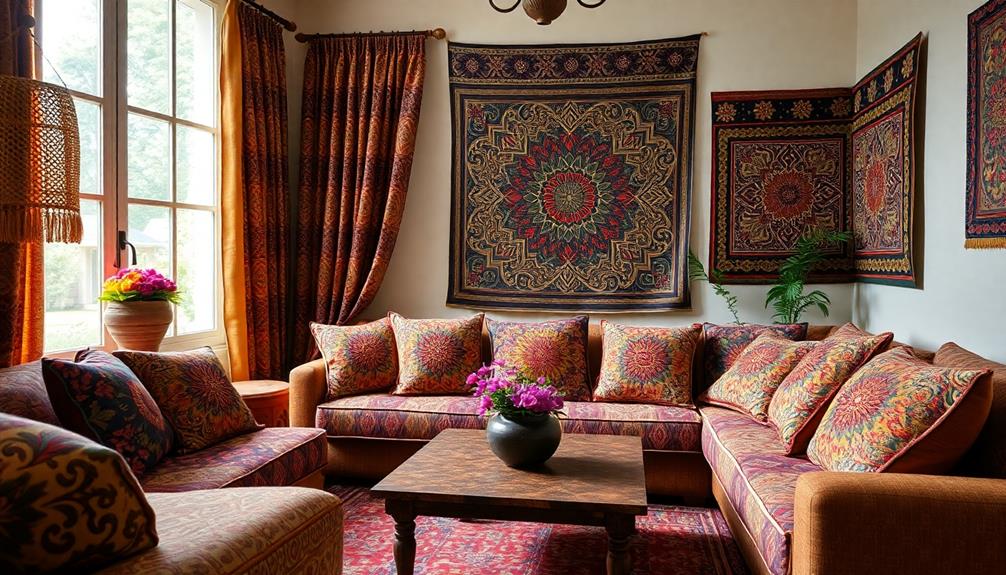
Batik brings a unique charm to home decor, effortlessly blending tradition with modern aesthetics. You can creatively integrate batik fabric into your living space in various ways, such as using batik to enhance the vibrant colors and intricate patterns found in traditional Indonesian style home decor.
For instance, framing batik patterns as wall art adds cultural flair and vibrant colors that transform any room. Batik cushion covers are another fantastic option; simply slip them over plain cushions to make a bold statement while enhancing comfort and style.
If you're looking to elevate your dining experience, consider using batik table runners and placemats. They're perfect for both special occasions and everyday meals, bringing elegance to your table.
Additionally, you can craft functional batik-inspired items like coasters, trays, and storage boxes using decoupage techniques. This showcases artistic style while providing sustainable decor solutions.
One of the best features of batik fabric is its durability. It withstands spills and stains, so you won't have to worry about maintenance while enjoying its vibrant designs.
Stylish Batik Accessories
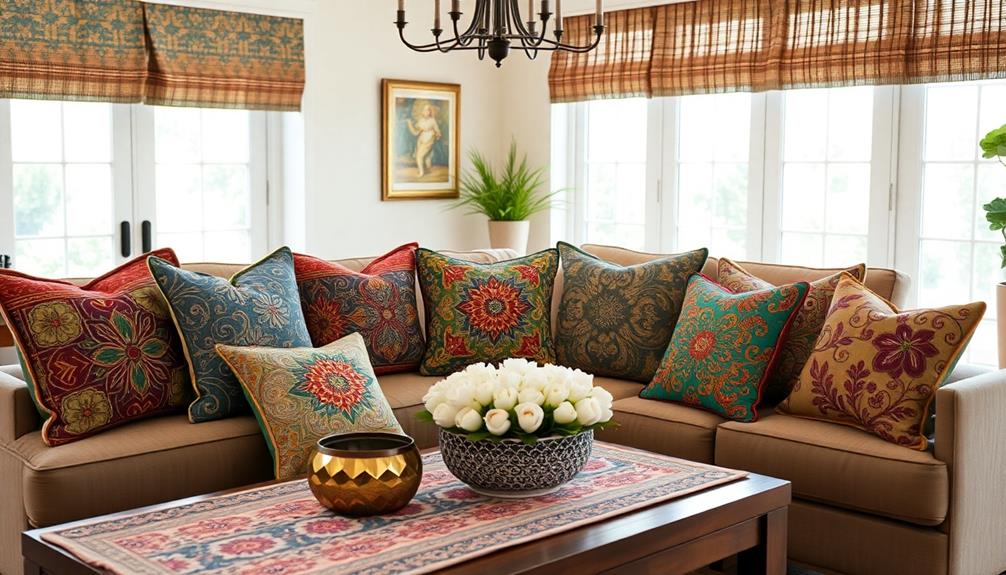
When you think about adding a touch of elegance to your home, unique batik coasters and elegant batik trays can make a big difference.
These pieces not only serve practical purposes but also showcase the vibrant colors and intricate patterns of traditional Indonesian textiles. Incorporating these accessories allows you to embrace traditional artistry while enhancing your living space.
Unique Batik Coasters
Adding a touch of Indonesian artistry to your home is easy with unique batik coasters. These coasters feature vibrant colors and intricate patterns that not only enhance your decor but also reflect the rich cultural significance of batik. Each piece is crafted using traditional wax-resist dyeing techniques, ensuring it's truly one-of-a-kind.
Moreover, they represent the rich cultural heritage and traditions of Indonesia, making them a great conversation starter about the importance of Indonesian decor masks.
Functional yet decorative, batik coasters effectively protect your surfaces from heat and moisture while adding elegance to your dining or coffee tables. You'll appreciate how they transform everyday moments into special occasions.
Plus, many coasters are made using sustainable practices, with upcycled materials that support local artisans and promote environmental awareness.
These unique batik coasters aren't just perfect for your home; they also make excellent gifts. Combining artistic beauty with practicality, they're ideal for celebrating special occasions or as thoughtful housewarming presents.
Whether you're enjoying a cup of coffee or hosting friends, these coasters can elevate your experience. So, why not invite a piece of Indonesia into your life? Your guests will surely admire the unique patterns and stories behind each batik creation, making your home feel even more inviting.
Elegant Batik Trays
If you love the vibrant, intricate designs of batik coasters, you'll appreciate the beauty of elegant batik trays. These stunning pieces showcase the stunning patterns and colors that highlight Indonesia's rich cultural heritage. Not only do they serve practical purposes, like organizing or serving items, but they also act as artistic statement pieces that spark conversations.
You can personalize your batik trays using decoupage techniques, allowing you to choose from various designs that resonate with your aesthetic preferences. Plus, by using upcycled materials, you promote sustainable practices while preserving this traditional art form.
Here's a quick overview of the benefits of elegant batik trays:
| Feature | Description | Benefit |
|---|---|---|
| Customizability | Various designs available | Tailored to your style |
| Functionality | Serve or organize items | Practical use in everyday life |
| Artistic Value | Reflects intricate craftsmanship | Serves as a conversation starter |
| Cultural Significance | Highlights Indonesian heritage | Connects you to a rich artistic tradition |
Elegant batik trays make thoughtful gifts, combining practicality with a unique cultural touch that celebrates the artistry of Indonesian textile traditions.
Unique Table Settings

There's something special about setting a table that combines functionality with artistry, and Indonesian batik cloth offers a stunning way to achieve that. You can creatively use batik fabric as table runners or placemats, instantly enhancing your dining experience with vibrant colors and intricate patterns.
Imagine your table adorned with geometric designs that tell a story, enchanting your guests and adding a cultural flair to your meals.
When you choose contrasting batik patterns, the visual impact becomes even more striking. The durable nature of batik fabric means it can withstand spills and stains, making it perfect for both special occasions and everyday dining.
Plus, by incorporating batik elements, you not only showcase Indonesian artistry but also support sustainable practices by using traditional crafts in your home decor.
To elevate your table settings, coordinate your batik with matching or complementary tableware. This approach creates a cohesive and elegant design that draws the eye.
Keep in mind that batik is made through a meticulous process where wax is applied to the fabric, adding to the uniqueness of each piece. With batik, your table settings can transform from mundane to magnificent.
Incorporating Batik in Fashion

You can easily incorporate batik into your everyday wear, adding a unique touch to your style.
As fashion collaborations featuring this vibrant fabric grow, you'll find more options that showcase its cultural significance and versatility.
Plus, choosing batik supports sustainable fashion choices, allowing you to express your identity while promoting ethical practices.
Batik in Everyday Wear
Batik fabric has seamlessly woven its way into everyday fashion, transforming casual and formal wardrobes alike. Known for its intricate designs and vibrant colors, batik brings a touch of Indonesian culture to your daily attire.
The hot wax technique used in batik allows for unique patterns that express your individual style while telling a story.
Here are three stylish ways to incorporate batik into your wardrobe:
- Casual Tops: Pair a batik-patterned blouse with jeans for a chic, laid-back look. The vibrant patterns will make your outfit pop without overwhelming it.
- Dresses: Opt for a batik wrap dress for a stunning choice that works both at brunch and formal events. The intricate designs add elegance and cultural richness.
- Accessories: If you're not ready to commit to full garments, try batik scarves or bags. They're perfect for adding a splash of color and a hint of tradition to any outfit.
Fashion Collaborations and Trends
As the world of fashion evolves, the integration of batik patterns into contemporary collections showcases a beautiful fusion of tradition and modernity. You'll find that fashion collaborations between Indonesian batik artisans and international brands create unique pieces that celebrate cultural heritage while appealing to a global audience. This trend not only highlights the versatility of batik but also aligns with the growing demand for sustainable fashion.
Celebrities have embraced batik, wearing it in various forms—from dresses to accessories like bags and scarves. This visibility boosts its popularity and reinforces its significance in today's fashion landscape. Here's a look at some notable collaborations and trends:
| Brand | Collaboration Type | Batik Usage |
|---|---|---|
| Brand A | Limited Edition Collection | Dresses |
| Brand B | Accessories Line | Bags and Scarves |
| Brand C | Capsule Collection | Swimwear |
| Brand D | Runway Show | Streetwear |
| Brand E | Sustainable Initiative | Everyday Apparel |
These partnerships not only showcase the beauty of batik but also promote a sustainable ethos in fashion, making it a must-have in your wardrobe!
Sustainable Style Choices
Incorporating batik into your wardrobe offers a stylish and sustainable choice that reflects both cultural richness and environmental consciousness. By choosing batik, you not only embrace vibrant designs but also support traditional craftsmanship that has been passed down through generations.
Here are three reasons why batik is an excellent addition to your sustainable style choices:
- Ethical Production: Batik fabrics are often made using natural materials and eco-friendly methods, reducing the environmental impact compared to fast fashion.
- Cultural Heritage: Wearing batik helps preserve the artistry of local artisans, keeping their traditions alive while promoting their livelihoods.
- Versatile Fashion: Batik can be used in a variety of clothing items—dresses, shirts, and accessories—making it easy to integrate into your wardrobe.
As contemporary designers collaborate with Indonesian artisans, the popularity of batik continues to grow in eco-friendly fashion collections.
Cultural Significance of Batik

A stunning array of intricate patterns and vibrant colors makes batik a profound symbol of Indonesian culture. Recognized by UNESCO as an Intangible Cultural Heritage of Humanity, batik embodies the rich cultural identity and exceptional craftsmanship of Indonesia.
Each batik pattern tells a story, conveying beliefs and social statuses, with specific designs traditionally reserved for royalty and the upper class.
You'll find batik woven into the fabric of daily life, used in traditional ceremonies, clothing, and home decor. This textile serves as a powerful means of cultural expression, fostering community pride across Indonesia.
By choosing batik, you're not just decorating your home; you're embracing a piece of history and identity.
The preservation and promotion of batik art are essential, ensuring the survival of this unique cultural heritage while supporting local artisans economically.
When you hang a batik piece in your home, you contribute to the ongoing legacy of this craft, celebrating the artistry and cultural significance that batik represents.
It's more than just a pattern; it's a connection to Indonesia's past and a vibrant part of its present.
Sustainable Crafting Practices

Sustainable crafting practices in batik are reshaping the way artisans create and connect with their environment. By focusing on eco-friendly methods, you can enjoy beautiful textiles while supporting a healthier planet.
Here are three key elements of sustainable batik crafting:
- Upcycled Materials: Many artisans use upcycled fabrics, transforming waste into stunning pieces. This approach minimizes environmental impact while showcasing creativity.
- Natural Dyes: Employing dyes derived from plants, fruits, and minerals enhances your batik's aesthetic while reducing reliance on harmful synthetic chemicals. You'll appreciate the unique shades and textures these natural ingredients provide.
- Locally Sourced Materials: Using materials sourced from nearby areas not only supports local economies but also cuts down on carbon footprints. Embracing traditional techniques, artisans preserve cultural heritage and promote sustainable craftsmanship.
Frequently Asked Questions
What Is the Famous Fabric Design of Indonesia?
The famous fabric design of Indonesia is batik. You'll love its intricate patterns and vibrant colors, created through a unique wax-resist dyeing technique that reflects rich cultural significance and craftsmanship passed down through generations.
What Is a Form of Textile Design From Indonesia?
When it comes to textile design from Indonesia, you can't go wrong with batik. This unique technique uses wax to create stunning patterns, showcasing vibrant colors and rich cultural significance that truly captivates the eye.
What Is the Indonesian Method of Producing Colored Designs?
The Indonesian method of producing colored designs often involves batik, where you apply molten wax to fabric before dyeing. This technique allows you to create intricate patterns through multiple dyeing and waxing stages for vibrant results.
What Is a Batik Design?
Batik design's like a dance of colors on fabric, where intricate patterns emerge through a wax-resist dyeing technique. You'll find each piece tells a story, reflecting culture, tradition, and craftsmanship in every detail.
Conclusion
Incorporating Indonesian textile patterns like batik into your home is a surefire way to elevate your space from drab to fab. Imagine walking into a room that feels like a vibrant art gallery, each piece telling a story. From stylish accessories to unique table settings, the possibilities are endless. So, grab your crafting supplies and let your creativity flow—your home deserves a touch of this timeless heritage, even if it's more "Instagrammable" than your grandma's living room!
Home Decor & Design
7 Indonesian Fabric Ideas That Will Wow Your Guests
You’ll discover stunning ways to incorporate Indonesian fabrics into your home that will leave your guests in awe and eager to learn more.
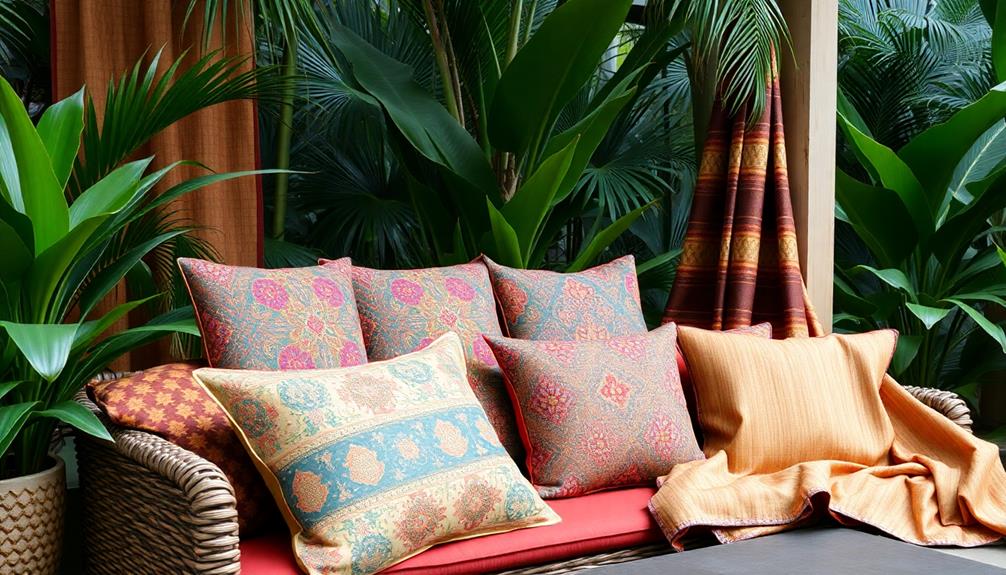
You can wow your guests with beautiful Indonesian fabrics by incorporating batik textiles into your home. Start with stunning batik wall art that serves as a fascinating conversation starter. Transform your living space with unique batik cushion covers that add vibrant touches. Don't forget elegant batik table settings to impress during meals. Creative batik home accessories can enhance your decor with cultural flair. Consider lurik fabric for its rich patterns and versatility in decor. Embracing these ideas will create an inviting atmosphere, and you'll discover even more ways to elevate your decor if you keep exploring the options available.
Key Takeaways
- Incorporate batik wall art to create a stunning focal point that reflects Indonesian culture and craftsmanship in your home decor.
- Use batik cushion covers to transform ordinary seating into vibrant, eye-catching elements that add comfort and style to your living space.
- Enhance dining experiences with batik table runners and placemats that create a cohesive and culturally rich table setting for guests.
- Explore unique lurik fabric products, such as bags and coasters, to showcase vibrant patterns while supporting local artisans.
- Create DIY batik projects, like wall art or decorative throws, to add personalized touches that impress guests and celebrate Indonesian traditions.
Exploring Batik Textiles
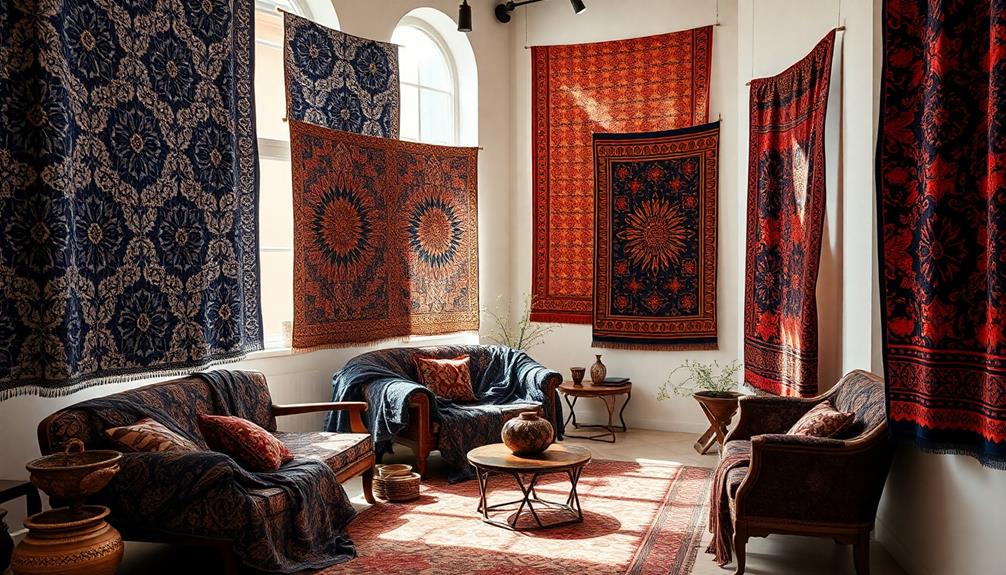
In the vibrant world of Indonesian textiles, batik stands out as a remarkable art form that showcases the country's rich cultural heritage. This traditional weaving technique involves a wax-resist dyeing process that allows artisans to create intricate, multi-layered designs.
As you explore batik, you'll discover that each pattern tells a story, often featuring cultural symbols and motifs that reflect Indonesia's diverse traditions. Not only do these textiles enhance the aesthetic of your home, but they also offer a versatile addition to various styles of decor.
The term "batik" comes from Javanese words meaning "to write" and "dot," which perfectly encapsulates the meticulous craftsmanship involved. Artisans use tools like the canting for hand-drawn designs (batik tulis) and stamped blocks (batik cap) to produce unique textiles.
Historically, certain batik patterns, such as Parang and Kawung, indicated social status, making them even more significant.
Incorporating Indonesian batik into your home decor can elevate your space with a touch of elegance and cultural depth. Whether you opt for a stunning batik tablecloth or decorative pillows, these textiles bring warmth and artistry to your environment.
As you embrace batik, you're not just adding beauty to your home; you're celebrating a cherished aspect of Indonesian identity and heritage.
Stunning Batik Wall Art
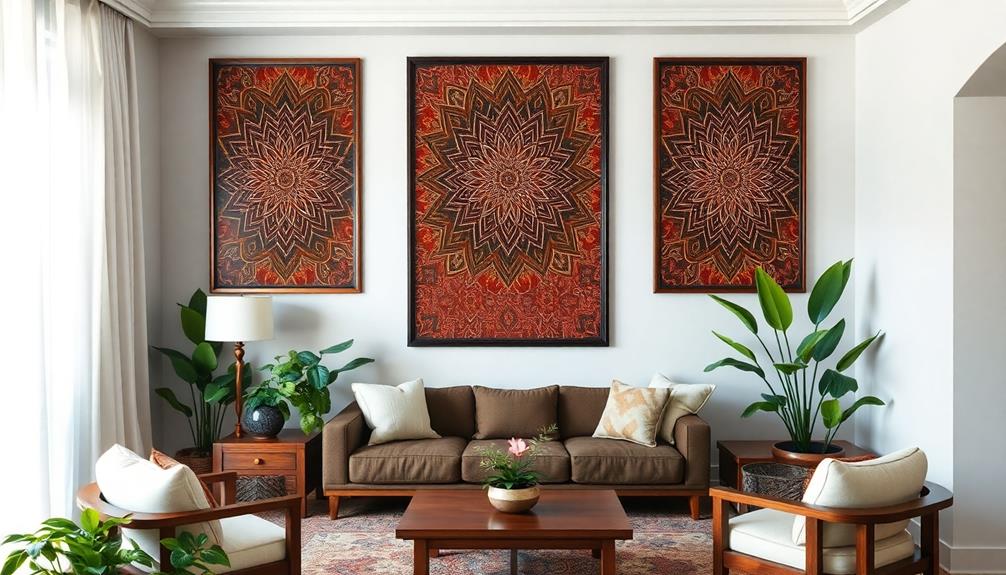
If you're looking to elevate your decor, stunning batik wall art might be the perfect choice.
These pieces often reflect traditional artistry that celebrates Indonesia's vibrant culture. You can explore various framing techniques, play with color combinations, and highlight the cultural significance of each piece.
This approach not only beautifies your space but also connects you to the rich heritage behind batik.
Framing Techniques Explained
Transforming vibrant batik fabric into stunning wall art requires thoughtful framing techniques that enhance its intricate patterns and colors. Start by selecting eye-catching batik pieces made using traditional methods, as these will be the focal points of your display.
Consider incorporating Indonesian decor masks alongside your batik art to create a cohesive cultural theme. To add depth and dimension, consider using matting and shadow boxes. These techniques not only showcase the fabric beautifully but also create a sense of space around it, making your art stand out.
Think about combining different batik patterns within a single frame for a dynamic look that reflects the richness of Indonesian culture. This approach can create a visually interesting display that tells a story.
Use adhesive or sewing methods to securely attach the fabric to backing boards; this guarantees a polished presentation that's easy to hang.
Color Combination Tips
When creating stunning batik wall art, combining different patterns with complementary colors can greatly enhance your design's visual appeal.
Start by selecting a vibrant color palette that includes at least one shade of green. This color not only harmonizes beautifully with the bold hues typical of batik but also offers a calming focal point in your space.
Incorporating elements like Indonesian decor masks can further enrich the cultural narrative of your design, adding depth and character.
To elevate your design, consider these tips:
- Mix Different Textures: Combine smooth cotton with rougher weaves for added depth.
- Use a Frame: Protect your fabric while giving it a polished look.
- Play with Patterns: Choose batik designs that feature complementary colors to create visual interest.
- Experiment with Layouts: Arrange your pieces in a grid or asymmetrical pattern for dynamic impact.
- Focus on Cohesion: Guarantee that your colors and patterns work together to create a cohesive feel.
Cultural Significance Highlighted
Throughout history, batik has served as an essential expression of Indonesian culture, weaving stories and traditions into its intricate patterns. Recognized by UNESCO, this traditional fabric art form showcases vibrant colors and elaborate designs. The technique of wax resist dyeing allows artisans to create stunning, multi-layered visuals that can easily transform your living spaces into a cultural showcase.
Additionally, batik often complements other elements of Traditional Indonesian Style Home Decor, enhancing the overall aesthetic through its rich textures and colors.
Incorporating batik fabric into wall art adds a unique flair to your home. Each design often reflects local folklore and spiritual beliefs, making your decor not just visually appealing but also rich in meaning. You can create breathtaking batik wall art by framing individual pieces or combining various patterns, highlighting both the beauty and craftsmanship behind this traditional textile.
Using batik for wall art doesn't merely enhance aesthetic appeal; it also serves as a conversation starter. Guests will be intrigued by the stories behind each design, prompting discussions about Indonesian culture.
Unique Batik Cushion Covers
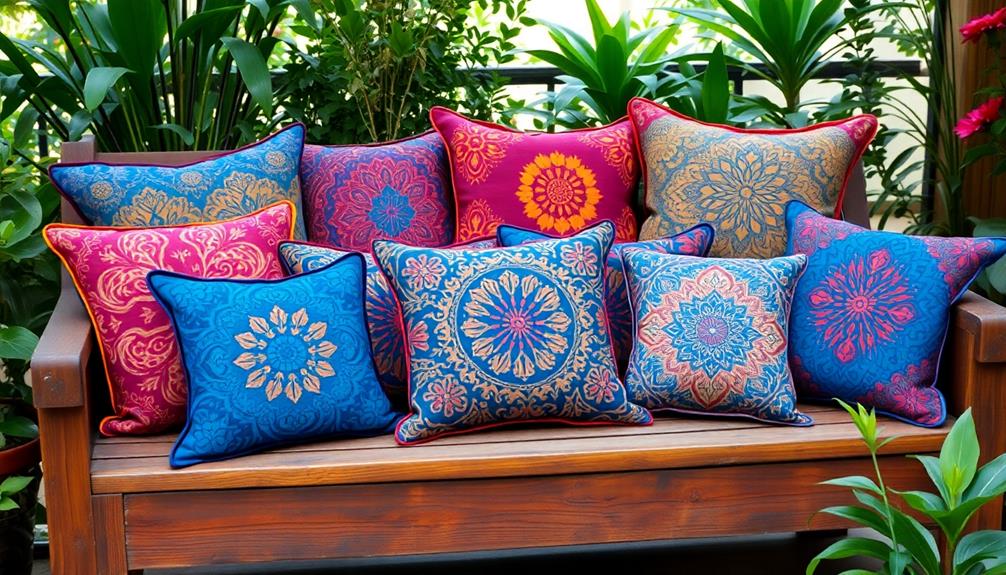
Often overlooked, unique batik cushion covers can truly elevate your home decor, turning ordinary cushions into vibrant focal points.
These covers showcase the intricate patterns and rich colors of traditional Indonesian batik, transforming your space with ease. If you're looking to add a personal touch, making your own batik cushion covers is an accessible DIY project, perfect for beginners.
By choosing contrasting colors and patterns, you can create visual interest and depth in your living spaces. Plus, batik fabric is durable and easy to maintain, ensuring your cushions withstand everyday use while retaining their beauty.
Incorporating these covers into your home decor not only enhances its aesthetic but also celebrates Indonesian cultural heritage.
Here are some reasons why you'll love batik cushion covers:
- Vibrant colors that instantly uplift your space
- Intricate patterns that tell a story
- Easy DIY projects for personal creativity
- Durable material that lasts through wear and tear
- Cultural significance that adds depth to your decor
Embrace the charm of unique batik cushion covers and watch as your home transforms into a vibrant, inviting haven.
Elegant Batik Table Settings

Transform your dining experience with elegant batik table settings that infuse life and culture into every meal.
Batik cloth can be transformed into stunning table runners or placemats, adding a vibrant cultural touch that'll impress your guests. The intricate patterns and rich colors of batik fabric enhance the visual appeal of your table settings, making them perfect for both special occasions and everyday use.
To create a cohesive and elegant dining atmosphere, coordinate batik designs with your other tableware. Whether you're using colorful dishes or simple glassware, batik can complement your overall theme beautifully.
Plus, the durable nature of batik fabric means it easily withstands spills and stains, ensuring that your stylish table settings remain practical.
Creative Batik Home Accessories
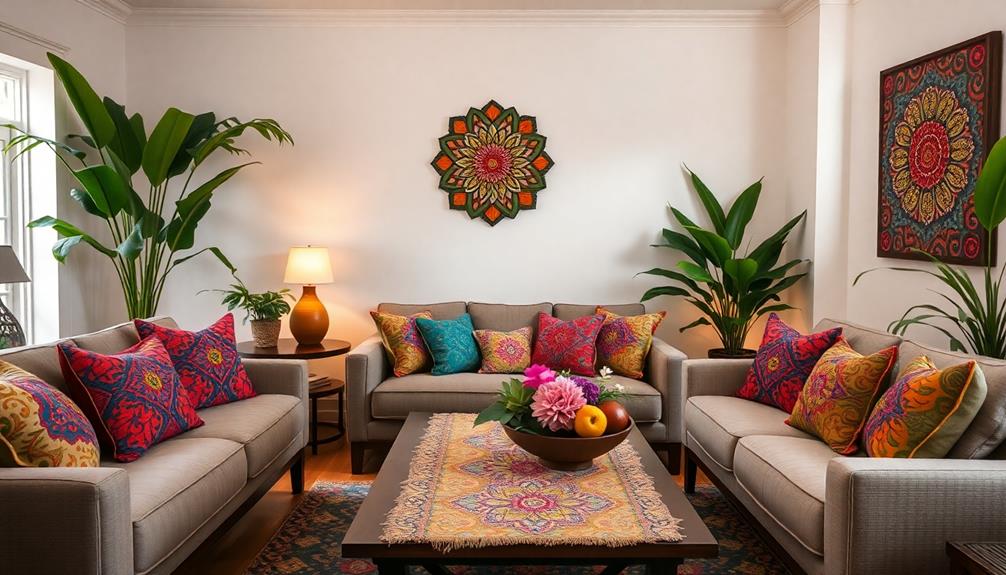
You can easily transform your living space with creative batik home accessories that showcase vibrant culture and artistry.
Consider stunning batik wall hangings to add a unique touch to your decor, or opt for elegant batik cushion covers that bring both comfort and color.
With thoughtful choices like these, you'll elevate your home's aesthetic effortlessly.
Stunning Batik Wall Hangings
Elevating your home decor with stunning batik wall hangings adds a vibrant touch that showcases the rich artistry of Indonesian textiles. By framing pieces of batik fabric, you create a polished and artistic focal point in any room.
The intricate designs, born from multi-layered wax resist techniques, bring depth and texture to your walls, making them truly eye-catching.
Consider combining various batik patterns and colors to express your unique cultural identity and create visual interest. The choice of adhesive or sewing techniques guarantees that your batik fabric remains securely displayed, preserving its vibrant hues for years to come.
Not only do these wall hangings enhance your decor, but they also serve as conversation starters, inviting your guests to appreciate the heritage of Indonesian textile art.
- Transform your living space with unique artistry
- Spark conversations about cultural heritage
- Infuse vibrant colors and intricate patterns
- Enjoy the depth and texture of handcrafted designs
- Create a warm, inviting atmosphere in your home
With stunning batik wall hangings, you'll wow your guests and celebrate the beauty of Indonesian craftsmanship.
Elegant Batik Cushion Covers
Adding elegant batik cushion covers instantly enhances your home's aesthetic, infusing each room with the vibrant colors and intricate patterns that define Indonesian textiles. These cushion covers can transform plain cushions, adding a lively touch to your decor.
Whether you choose rich blues, warm reds, or bright yellows, the striking designs of batik will surely catch your guests' eyes.
Creating these cushion covers is an easy sewing project, perfect for beginners. You can upgrade your living space quickly without needing advanced skills.
Experimenting with contrasting colors and patterns from various batik fabrics allows you to make bold statements, enhancing the visual interest in your home.
Not only do batik cushion covers provide comfort, but they also celebrate Indonesian cultural heritage, making them unique conversation pieces. Guests will appreciate the story behind each piece, adding depth to your decor.
Plus, incorporating batik into your home accessories promotes sustainable crafting practices. Many batik textiles are handwoven and eco-friendly, allowing you to contribute positively to the environment while beautifying your space.
Unique Batik Table Settings
Transforming your dining area with unique batik table settings can create a vibrant and inviting atmosphere. Batik cloth, with its intricate patterns and rich colors, can be beautifully crafted into table runners or placemats. This addition not only enhances your dining experience but also infuses your table with cultural flair.
By combining various batik patterns, you can create a visually enchanting table setting that will certainly impress your guests. The durability of batik fabric means it can withstand spills and stains, making it perfect for both special occasions and everyday use.
To elevate the overall aesthetic, coordinate your batik table settings with complementary tableware for a cohesive design theme. Don't forget to include batik accessories, as they can further enhance the dining experience and showcase your artistic style.
Consider adding these elements to your table setting:
- Vibrant batik table runners
- Colorful placemats
- Artistic coasters
- Elegant napkin holders
- Unique serving trays
With these unique batik table settings, you'll create an unforgettable dining experience that your guests will cherish.
Lurik Fabric Transformations
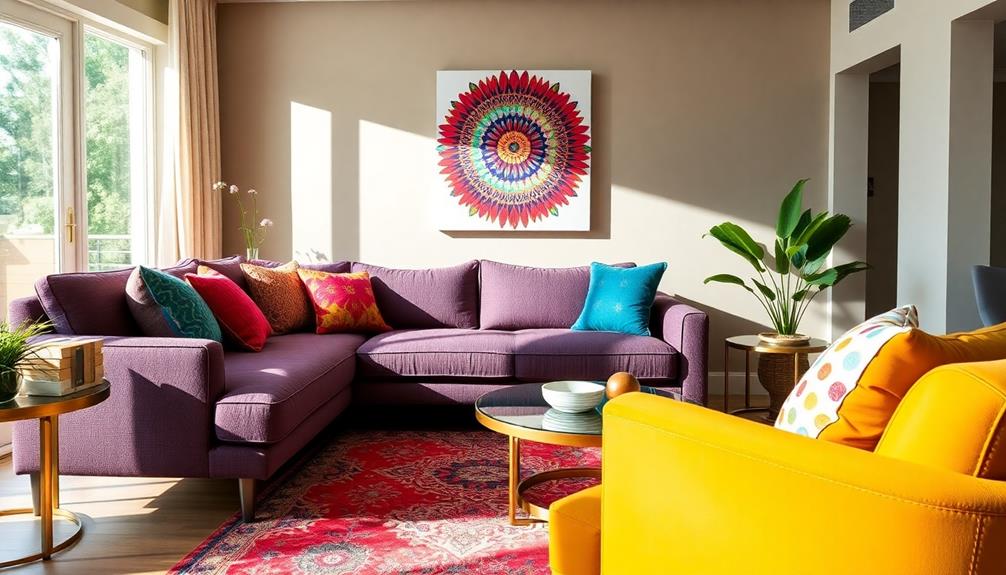
Lurik fabric, with its vibrant striped patterns and rich cultural history, offers a unique opportunity to enhance your home and wardrobe. Traditionally associated with lower social status, this fabric has transformed into a stylish choice for various applications.
Using lurik for cushion covers not only adds comfort but introduces a rough texture that captivates the eye. Imagine your living space adorned with these unique accents, showcasing Indonesian heritage. You can also elevate your dining experience by incorporating lurik into table settings, such as runners and placemats, providing an elegant touch.
Here's how you can creatively use lurik fabric:
| Project | Description |
|---|---|
| Cushion Covers | Durable and visually striking for your living room. |
| Table Settings | Elegant runners and placemats for dining occasions. |
| Accessories | Stylish bags and coasters celebrating craftsmanship. |
With its versatility, lurik can even be transformed into DIY wall art or decorative throws, making it an ideal choice for impressing guests. By embracing lurik fabric, you blend traditional craftsmanship with modern aesthetics, creating stunning pieces that truly wow.
Celebrating Indonesian Weaving Traditions

Indonesian weaving traditions are a vibrant tapestry of culture, history, and artistry that deserve to be celebrated. Each fabric tells a story, connecting you to the rich heritage and craftsmanship that has been passed down through generations.
When you embrace these textiles, you're not just wearing a piece of clothing; you're honoring the cultural significance behind each thread.
- Experience the intricate patterns of batik, recognized by UNESCO as a masterpiece.
- Feel the community spirit embodied in tenun, which plays a key role in life events and rituals.
- Discover how lurik's transformation from humble origins to high fashion reflects resilience and creativity.
- Support local artisans, ensuring their skills and stories thrive for future generations.
- Take pride in contributing to sustainable craftsmanship and cultural tourism in Indonesia.
Frequently Asked Questions
What Is the Famous Fabric Design of Indonesia?
Batik is Indonesia's most famous fabric design, renowned for its intricate patterns and wax-resist dyeing technique. When you explore its beauty, you'll discover a rich cultural heritage that truly captivates and inspires.
What Are the Different Types of Fabrics in Indonesia?
You might think all fabrics are the same, but Indonesia's textiles—like Batik's intricate patterns, luxurious Songket, and meaningful Tenun—offer a vibrant tapestry of culture. Each type tells a unique story that captivates.
What Does Batik Mean in Indonesian?
In Indonesian, "batik" means the art of applying wax to fabric to create intricate patterns. You'll find it symbolizes cultural heritage, with each design telling a story about social status and tradition.
What Can I Make With Batik Fabric?
You can create stunning wall art by framing batik pieces, craft unique cushion covers for vibrant accents, or make elegant table runners. Don't forget to try decoupage for coasters and storage boxes, too!
Conclusion
Incorporating Indonesian fabrics into your home can truly elevate your space and impress your guests. Imagine hosting a dinner party with a stunning Batik tablecloth that sparks conversations and admiration. You could even showcase unique Batik cushion covers that reflect your personal style, creating a warm and inviting atmosphere. By embracing these vibrant textiles, you'll not only celebrate Indonesian culture but also transform your home into a fascinating haven that leaves a lasting impression on everyone who visits.
Home Decor & Design
How to Use Indonesian Fabrics to Create a Cultural Masterpiece at Home
Join us to explore the enchanting ways Indonesian fabrics can transform your home into a cultural masterpiece that tells a unique story.
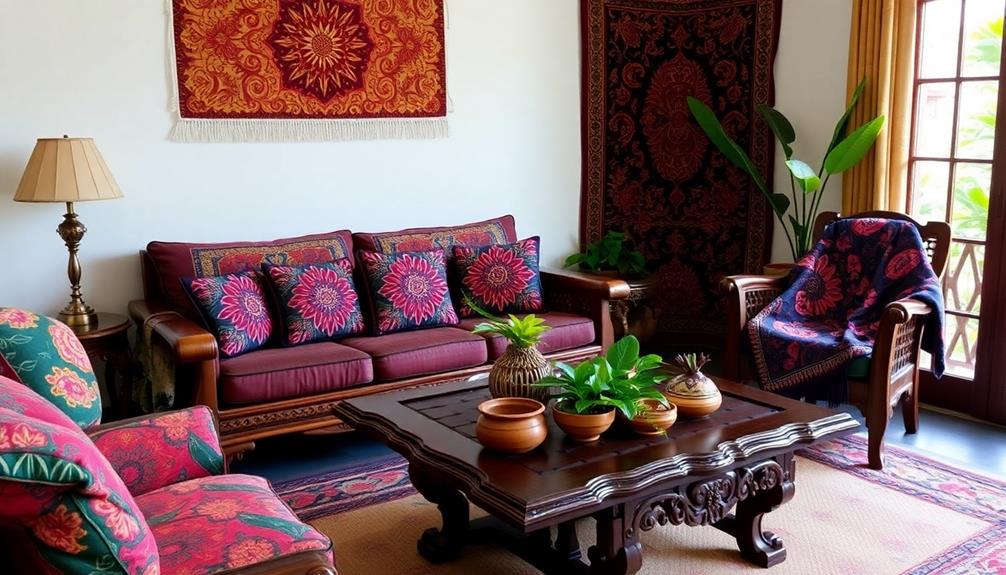
You can use Indonesian fabrics like batik and ikat to create stunning cultural masterpieces at home. Start by selecting vibrant batik wall art that reflects intricate designs and historical motifs. Use batik for cushion covers to add a unique flair to your living space. Incorporate these fabrics in table settings for a cohesive look during dining occasions. Don't forget to craft small accessories like coasters or keychains to showcase your love for Indonesian heritage. Each piece tells a story, inviting deep appreciation of the artistry involved. Discover more ideas that could inspire your next creative project!
Key Takeaways
- Select vibrant batik fabrics that reflect traditional Indonesian patterns to infuse cultural significance into your home decor projects.
- Utilize batik techniques, like wax-resist dyeing, to create unique wall art, cushion covers, and table settings that tell a story.
- Incorporate sustainable practices by using natural dyes and upcycled fabrics to promote eco-friendliness in your batik creations.
- Craft functional accessories, such as coasters and keychains, to showcase Indonesian culture in everyday items while enhancing your decor.
- Embrace cultural storytelling by choosing motifs that resonate with local folklore and heritage, enriching the ambiance of your living space.
Overview of Indonesian Fabrics
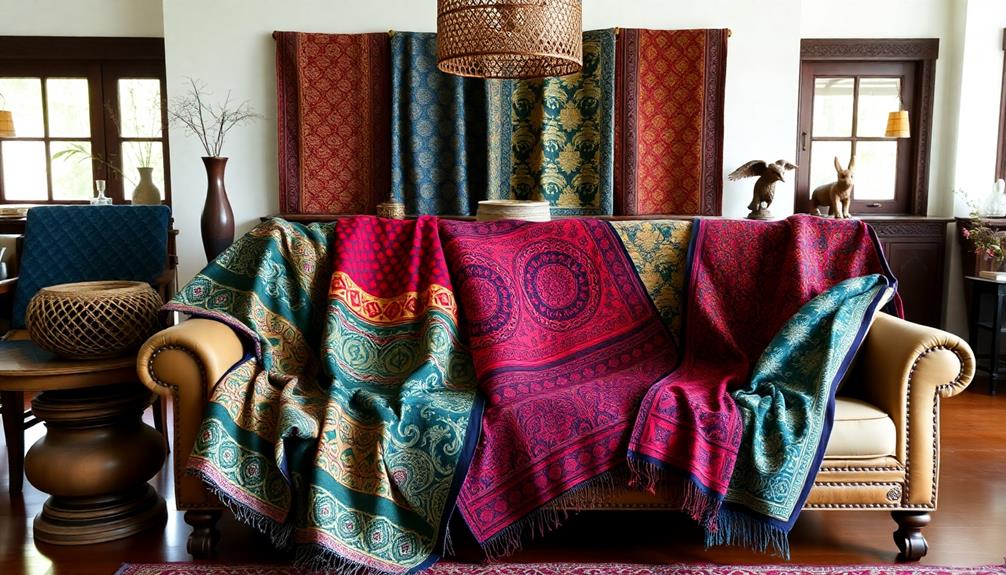
What makes Indonesian fabrics so enthralling? The answer lies in their vibrant colors and intricate patterns that reflect a rich cultural heritage. Among these, batik stands out as a UNESCO-recognized technique, where artisans use hot wax to create detailed designs on cotton fabric. This labor-intensive process results in stunning pieces, often dyed in a rainbow of colors, each telling a unique story.
Additionally, many of these fabrics are complemented beautifully by traditional Indonesian Decor Masks, which enhance the aesthetic appeal of any space. Another fascinating textile art form is ikat, where threads are dyed before weaving. This method creates a beautiful, blurred effect, adding depth and dimension to the fabric.
Both batik and ikat embody the spirit of Indonesia, with specific motifs representing local folklore, myths, and spiritual beliefs. Each fabric you encounter is more than just a design; it's a narrative woven into the very threads.
Indonesian fabrics aren't just for traditional garments; they're versatile enough to be used in clothing, home decor, and accessories. By incorporating these textiles into your space, you can celebrate and honor the cultural heritage of Indonesia while adding a splash of color and artistry to your everyday life.
Exploring Batik Techniques

When you explore batik techniques, you'll discover a world of design inspirations that reflect rich cultural traditions, including the vibrant artistry of Indonesian decor masks that showcase intricate designs.
You'll also learn about various dyeing techniques and how to apply wax using traditional tools to create stunning patterns.
Understanding these elements will help you appreciate the artistry behind each piece and inspire your own projects at home.
Batik Design Inspirations
Batik design inspirations are abundant, showcasing a stunning array of techniques that highlight Indonesia's rich cultural heritage. One of the most fascinating aspects of batik art is the wax-resist dyeing method, where artists apply hot wax to fabric to create intricate patterns. This technique not only preserves the fabric underneath but also allows for the development of detailed motifs using tools like the tjanting, which gives you precision in your designs.
Here's a quick overview of some popular batik techniques:
| Technique | Description |
|---|---|
| Wax-Resist Dyeing | Applying hot wax to create intricate patterns. |
| Tjanting Method | Using a tjanting tool for precise wax application. |
| Batik Stamping | Employing handcrafted copper stamps for repeating designs. |
Dyeing Techniques Overview
Dyeing techniques in batik offer a fascinating glimpse into the artistry behind this traditional textile. To create intricate designs, you'll begin by applying hot wax to the fabric using a tjanting tool. This wax acts as a resist, preventing dye penetration in the areas you want to keep untouched.
The dyeing process typically involves multiple cycles, starting with the lightest colors and gradually moving to darker hues. This layering technique allows for complex patterns that are visually striking, making batik a perfect choice for Indonesian decorative pillows that enhance living spaces.
You can use natural dyes derived from various plants and materials to achieve vibrant, eco-friendly colors, enhancing the cultural authenticity of your fabric. Once you've completed the dyeing process, it's time to remove the wax. Boiling the fabric will dissolve the wax, revealing the vibrant colors and intricate designs you've created.
Mastering these batik techniques requires practice and patience, as the precision in wax application and the timing of dyeing can greatly influence the final artwork. By exploring these dyeing methods, you can appreciate the skill and tradition behind batik, and create your own unique masterpiece at home.
Wax Application Methods
Mastering wax application methods is essential for creating stunning batik designs. This process involves using a tjanting tool or handcrafted copper stamps to control the hot wax precisely. As you apply the wax, it acts as a resist, preventing dye from penetrating those areas and forming the intricate patterns that batik is known for.
The artistry of batik reflects the rich cultural heritage of Indonesia, much like the importance of Indonesian decor masks which enhance aesthetic appeal and storytelling in home decor.
Here are some key techniques you can explore:
- Freehand drawing: Use a tjanting tool to create unique, flowing designs.
- Stamping: Dip handcrafted stamps into hot wax and press them onto the fabric for uniform motifs.
- Layering: Apply multiple layers of wax for complex designs, dyeing each layer sequentially.
- Detailing: Add fine lines and small accents with a tjanting for added intricacy.
- Experimentation: Mix and match techniques to personalize your batik creations.
Each method varies in complexity, so you can choose a technique that suits your skill level.
Selecting the Right Materials
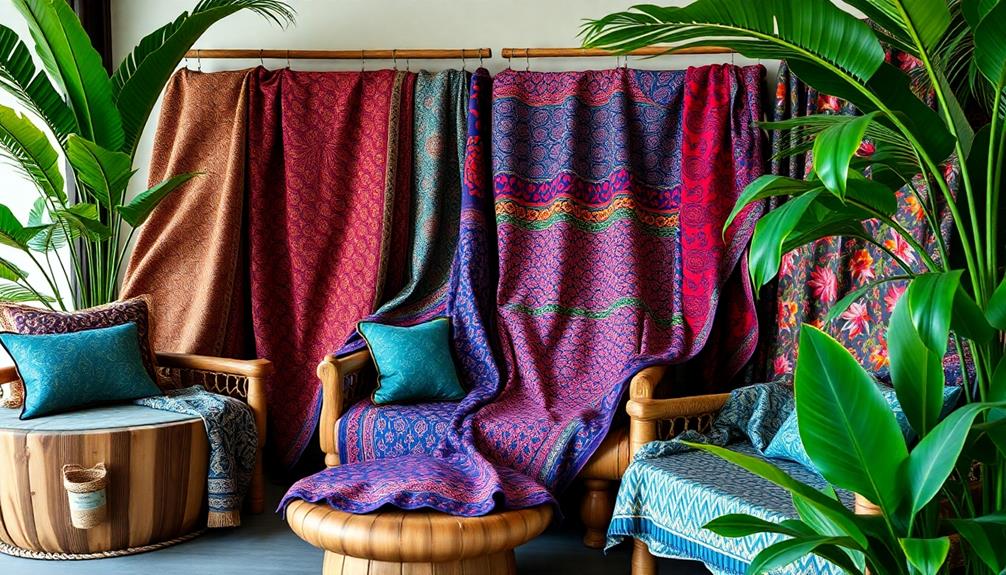
When selecting the right materials for your fabric projects, the choice of fabric is vital to achieving the best results. For batik projects, cotton fabric is your best bet. Its absorbency and compatibility with dyes make it ideal for creating intricate designs and vibrant colors.
Additionally, consider incorporating traditional Balinese motifs into your designs to enhance the cultural significance of your work, a reflection of Balinese design characteristics. You'll want to invest in high-quality paraffin and beeswax, either pre-mixed or combined, to guarantee effective wax application that creates a strong resist effect during dyeing.
To achieve the detailed patterns you desire, important tools like a tjanting for precision wax application and small paintbrushes for fine details are essential. Don't forget rubber gloves to protect your hands during the dyeing process.
When it comes to dyes, consider using cool water fiber reactive dyes for their permanent adherence and vibrant results. If you're looking for eco-friendly alternatives, experimenting with natural dyeing materials from plant-based items can be rewarding.
Lastly, confirm you have a stable workspace by securing your cotton fabric on a wooden frame. This will prevent movement during the wax application and dyeing processes, allowing for clean, detailed patterns that truly reflect the beauty of Indonesian fabrics.
Creating Batik Wall Art
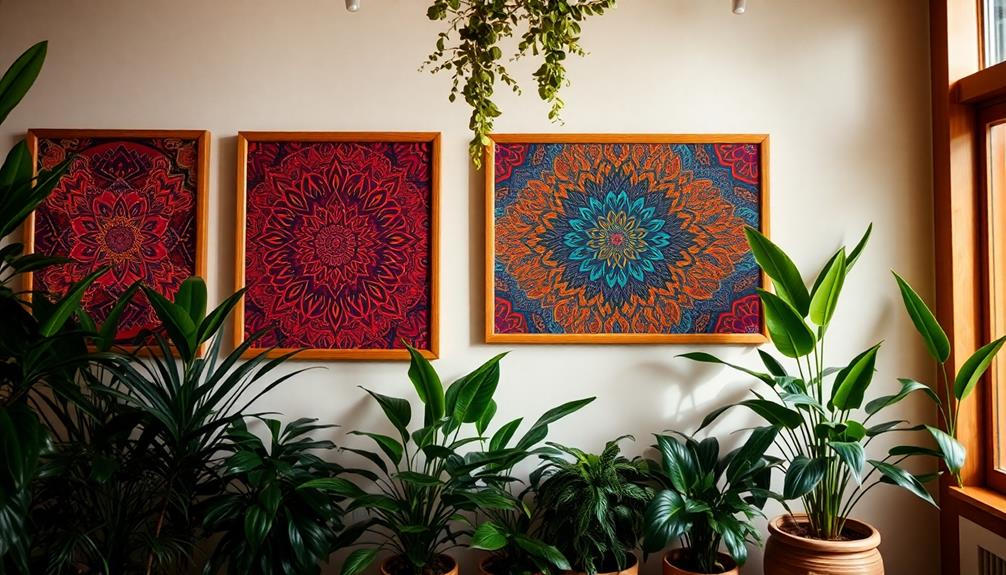
Creating stunning batik wall art begins with selecting vibrant batik fabric that showcases traditional Indonesian patterns and colors. You'll want to choose pieces that reflect the rich culture and artistry of Indonesia.
Here are some ideas to inspire your creation:
- Bold floral motifs that burst with color, capturing the essence of tropical landscapes.
- Intricate geometric designs that create a sense of harmony and balance.
- Soft, natural tones that evoke a sense of tranquility and peace.
- Layered patterns combining various batik styles for depth and visual interest.
- Textured embellishments like beads or threads to add dimension and uniqueness.
Once you've picked your fabrics, secure them onto a wooden frame using adhesive or sewing techniques, ensuring they remain taut.
Consider layering multiple pieces or adding embellishments to create a three-dimensional effect.
Finally, hang your completed batik wall art in a prominent space, letting everyone appreciate the intricate designs and cultural significance of this traditional craft.
Designing Batik Cushion Covers
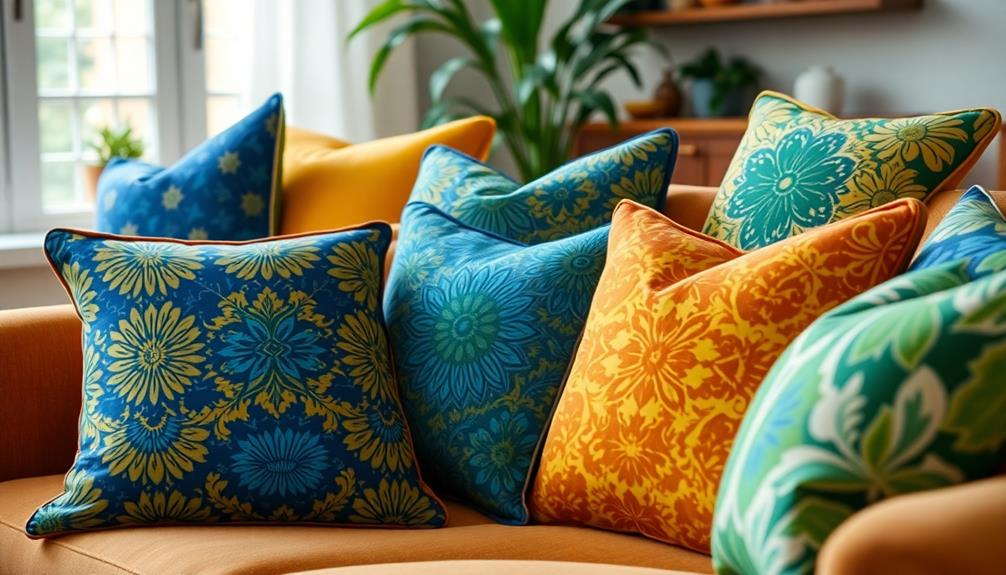
Designing batik cushion covers can transform your living space with vibrant colors and unique patterns. To get started, choose a batik fabric that contrasts well with your existing decor. This striking visual impact will breathe new life into your room. If you're a beginner, this sewing project is simple: measure your cushion dimensions, cut the batik fabric accordingly, and sew the pieces together.
Incorporating traditional Indonesian designs into your cushion covers not only enhances aesthetic appeal but also celebrates your cultural heritage. To elevate the look, consider adding embellishments like piping or buttons for a polished finish. Plus, handmade batik cushion covers are removable and washable, making them practical while adding cultural flair to your home.
Here's a quick reference table for your batik cushion cover project:
| Step | Material Needed | Notes |
|---|---|---|
| Measure | Measuring tape | Get accurate cushion dimensions |
| Cut | Batik fabric | Choose vibrant colors |
| Sew | Sewing machine/thread | Simple stitches work best |
With these tips, you can create stunning batik cushion covers that reflect your style and appreciation for Indonesian culture.
Batik Table Setting Ideas
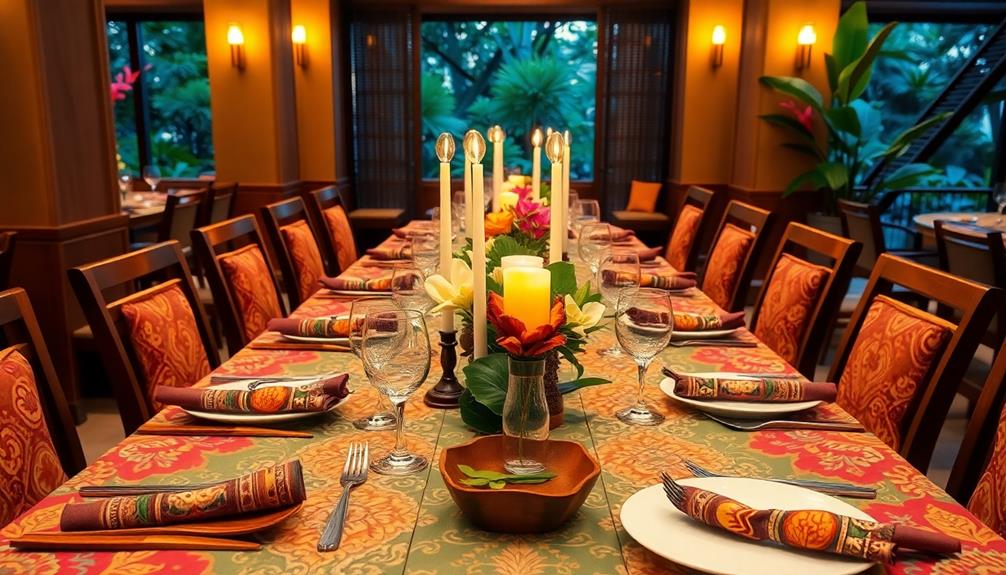
You can create an elegant dining experience by using vibrant batik cloth as table runners or placemats, instantly bringing a touch of Indonesian culture to your table.
Coordinating your tableware designs with contrasting batik patterns and colors not only enhances visual interest but also makes a bold statement.
Elegant Dining Experiences
With batik fabrics adorning your dining table, any meal transforms into an elegant experience. This rich art form, with its vibrant colors and intricate patterns, elevates your dining aesthetic, making every occasion feel special.
Here are some ideas to create a stunning batik table setting:
- Batik table runners that cascade down the center, adding texture and depth.
- Contrasting placemats that create a bold visual statement and capture attention.
- Stylish napkin rings made from batik fabric, showcasing cultural craftsmanship.
- Coasters featuring unique batik designs, protecting your table while enhancing the theme.
- Dishes and glassware that coordinate with your batik fabric for a cohesive look.
Opt for durable batik fabric that can withstand spills and stains, ensuring it's perfect for both everyday dining and formal gatherings.
By incorporating these elements, you'll create an ambiance that's not only visually stunning but also rich in cultural heritage.
Coordinated Tableware Designs
Elevate your dining experience by coordinating batik tableware designs that harmonize with the vibrant patterns of your batik fabrics. Start by using batik cloth as table runners or placemats, infusing your dining area with the rich colors and intricate details characteristic of Indonesian culture.
To really make a statement, choose contrasting colors in your batik tableware. This bold approach not only complements your dining theme but also creates a striking visual impact. Coordinate your batik napkins with plates and glasses for a cohesive design that enhances the overall dining experience.
Remember, batik fabric is durable, making it suitable for everyday use and resistant to spills and stains, so you don't have to worry about it losing its charm.
Additionally, consider incorporating batik-inspired coasters and centerpieces. These elements serve as functional art pieces that beautifully showcase Indonesia's rich cultural heritage.
With these coordinated tableware designs, you can transform any meal into a cultural masterpiece, celebrating the artistry and tradition embedded in batik while enjoying a wonderful dining atmosphere.
Crafting Batik Accessories

Batik accessories bring a vibrant touch to your home while showcasing the intricate artistry of this traditional Indonesian fabric. You can easily craft these unique pieces and incorporate them into your daily life, adding both beauty and functionality.
Consider creating:
- Batik coasters: Cut fabric squares and adhere them to cork or wood bases for a stylish, sustainable addition to your décor.
- Batik trays: Transform plain trays by covering them with batik fabric, perfect for serving guests or organizing items.
- Batik storage boxes: Wrap simple boxes in batik fabric, providing elegant storage solutions that reflect your personal style.
- Batik wall art: Use decoupage techniques to apply batik designs to canvas or wood, turning everyday objects into eye-catching focal points.
- Batik keychains: Create small fabric-covered keychains that showcase your love for Indonesian culture while keeping your keys stylishly organized.
Crafting batik accessories not only promotes sustainable practices by upcycling materials but also offers a creative outlet to express your appreciation for this rich cultural heritage.
Immerse yourself in your crafting journey and let the vibrant colors of batik inspire your creativity!
Incorporating Batik in Home Decor
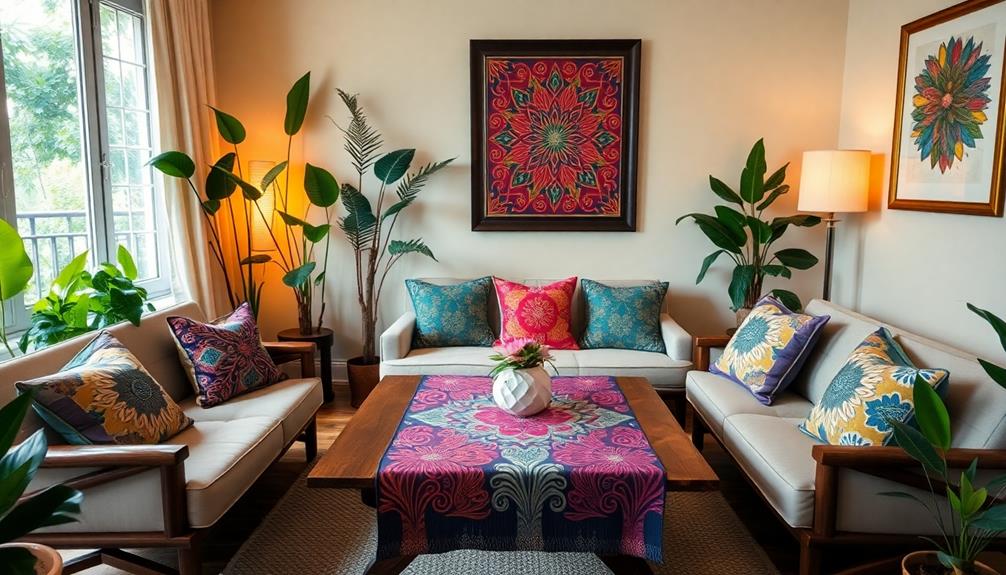
Adding batik to your home decor can instantly transform your space with its rich colors and intricate patterns. You can start by framing individual pieces of batik fabric or creating a gallery wall that showcases various designs. This adds cultural flair and serves as a stunning focal point in any room.
For a more functional approach, consider using batik fabric for cushion covers. Not only will this enhance comfort, but it'll also introduce vibrant colors into your living space. It's a simple DIY project that packs a big impact.
Elevate your dining experiences by incorporating batik as table runners or placemats. This unique touch coordinates beautifully with various tableware, perfect for special occasions or everyday meals.
You can also craft batik-inspired coasters and trays using decoupage techniques. These functional items become artistic statements that celebrate Indonesian culture.
Cultural Significance of Batik
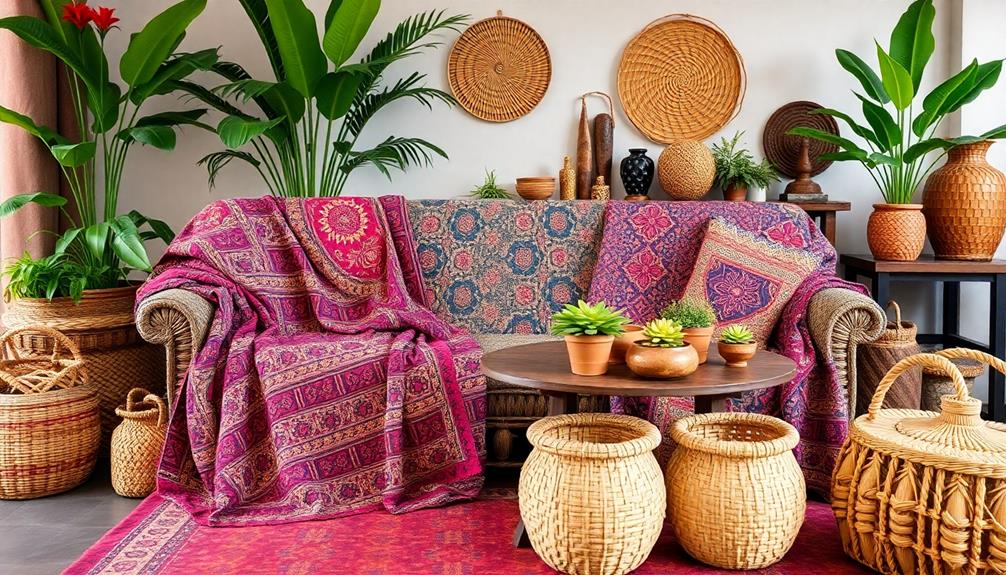
Batik's patterns aren't just beautiful; they carry deep symbolism, telling stories of local mythology and history.
Each design reflects the cultural roots of its region, showcasing unique styles that connect you to Indonesia's rich heritage.
Symbolism in Batik Patterns
Indonesia's rich tapestry of culture is vividly expressed through the intricate patterns of batik, where each design tells a story steeped in symbolism. The symbolism in batik patterns conveys deep cultural meanings, reflecting the history of batik and its significance in Indonesian heritage.
As you explore these beautiful textiles, consider the following motifs and their meanings:
- Parang: Symbolizes a never-ending struggle, often associated with power and royal lineage.
- Kawung: Represents the cyclical nature of life and is linked to wisdom and purity.
- Marine motifs: Vibrant coastal designs celebrate the sea's abundance and the joy of life.
- Earthy tones: Evoke stability and a connection to nature, grounding your space.
- Bright colors: Reflect joy and celebration, perfect for uplifting your home environment.
Each region in Indonesia has unique batik designs that tell local myths and traditions.
Batik's Historical Roots
Exploring the historical roots of batik reveals a rich tapestry of culture and tradition that dates back to at least the 12th century. Originating in Java, Indonesia, batik reflects deep cultural and spiritual connections within Indonesian society.
This intricate art form employs a wax-resist dyeing technique, creating patterns that hold historical and symbolic significance tied to the region, religion, and social status.
Batik gained international recognition at the Paris Exposition Universelle in 1900, showcasing its cultural importance and artistic value worldwide. Today, it's recognized by UNESCO as an Intangible Cultural Heritage, highlighting its essential role in preserving Indonesian traditions and storytelling.
Each batik piece tells a unique story, with specific motifs associated with royalty or significant cultural events.
When you incorporate batik into your home, you're not just adding a beautiful design; you're embracing a piece of Indonesian cultural heritage.
Each fabric you choose carries with it the history and artistry of generations. By celebrating batik, you honor its legacy, allowing its rich narrative to enhance your living space and connect you to a profound cultural lineage.
Sustainable Practices in Batik Art
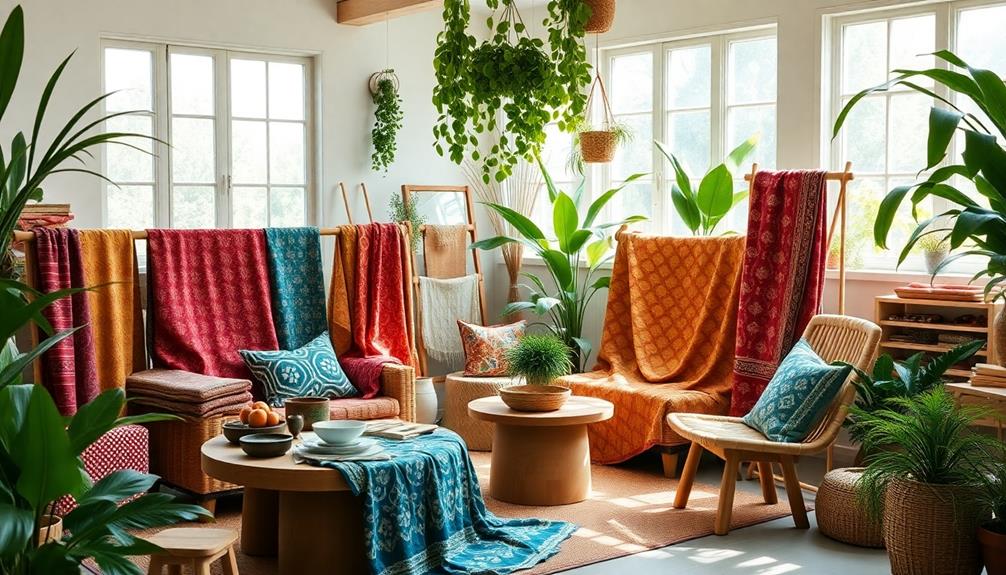
Sustainable practices in batik art are transforming the way artisans approach their craft, emphasizing eco-friendliness and cultural preservation.
By focusing on sustainable methods, you can appreciate the beauty of batik while supporting the environment.
Here are some key elements of sustainable batik practices:
- Natural Dyes: Artisans use vibrant colors derived from fruits, vegetables, and plants, minimizing harmful synthetic chemicals.
- Upcycled Fabrics: Many artisans prioritize repurposing materials, reducing waste and showcasing creative resourcefulness.
- Biodegradable Materials: Incorporating these materials enhances the eco-friendliness of batik products, appealing to conscious consumers.
- Cultural Heritage: Traditional techniques passed down through generations not only preserve artistry but also support local economies.
- Educational Workshops: Classes that teach batik techniques often highlight sustainable practices, fostering appreciation for eco-conscious art forms.
Frequently Asked Questions
Can I Do Batik at Home?
Yes, you can definitely do batik at home! Gather cotton fabric, wax, and dye, then follow the process of applying wax and dye to create beautiful, intricate designs that reflect your unique style and creativity.
What Is the Indonesian Method of Painting on Cloth?
"Where there's a will, there's a way." The Indonesian method of painting on cloth, or batik, involves applying hot wax to fabric, creating stunning patterns that resist dye, resulting in beautiful, colorful designs you'll cherish.
What Is the Famous Fabric Design of Indonesia?
The famous fabric design of Indonesia is Batik. You'll love its intricate patterns and vibrant colors that tell cultural stories. Each region offers unique designs, reflecting local heritage through beautiful motifs and detailed craftsmanship.
How to Do Batik Step by Step?
To do batik, start by preparing your fabric and transferring your design. Apply hot wax with a tjanting tool, then dye the fabric. Finally, remove the wax to reveal your beautiful batik creation. Enjoy!
Conclusion
By incorporating Indonesian fabrics into your home, you're not just decorating; you're celebrating a rich cultural tradition. Whether you're crafting wall art, cushion covers, or unique accessories, each piece tells a story that connects you to the artistry of Batik. So, why not transform your space into a cultural masterpiece that reflects your style and appreciation for global heritage? Embrace these sustainable practices and let your creativity flourish with every stitch and dye.
Home Decor & Design
The Magic of Indonesian Textiles: How to Elevate Your Interior Effortlessly
Discover how Indonesian textiles can transform your space into a stunning blend of beauty and tradition, leaving you inspired to elevate your interior design.

Indonesian textiles, with their enchanting patterns and rich heritage, can effortlessly elevate your interior design. Incorporate stunning Batik wall hangings or upholstered cushions to serve as stylish focal points. Use Ikat-patterned curtains to enhance natural light and create a warm ambiance. Layer different textile techniques, like Batik Tulis and Batik Cap, to celebrate craftsmanship. Opt for earthy tones to align with contemporary design trends while ensuring authenticity and comfort. Each piece tells a unique story, connecting you to a vibrant culture. Explore how these textiles transform your space into a blend of beauty and tradition.
Key Takeaways
- Incorporate Batik wall hangings or large cushions as focal points to create conversation starters and enhance cultural richness in your space.
- Layer Batik throws on sofas for added warmth and texture, creating a cozy and inviting atmosphere in your living area.
- Use Ikat-patterned curtains in earthy colors to enhance natural light while providing a stylish touch to your interior design.
- Combine different Batik techniques like Batik Tulis and Batik Cap to honor craftsmanship and add unique visual interest to your decor.
- Choose authentic Indonesian textiles made from natural fibers in muted or earthy tones for a sophisticated and serene ambiance.
Understanding Indonesian Textiles

When exploring Indonesian textiles, you'll discover a vibrant world steeped in history and artistry. These textiles, especially batik and ikat, are rooted in rich cultural traditions that span over 2,000 years.
Batik, known for its intricate patterns and cultural significance, comes in three main types: Batik Tulis (hand-drawn), Batik Cap (stamped), and Batik Lukis (painted). Each method showcases unique artistry and reflects the labor-intensive processes involved.
Additionally, the beauty of Indonesian decor masks, which often complement these textiles, enhances the overall aesthetic of any space and encourages an appreciation for traditional craftsmanship.
Ikat weaving adds another layer of beauty, involving binding, dyeing, and weaving threads to create designs that often symbolize cosmic creation. This process encapsulates the spiritual beliefs of the communities behind the textiles.
Traditional motifs seen in these fabrics not only serve decorative purposes but also embody the shared cultural heritage and spirituality of Indonesia's diverse cultures.
As you explore deeper, you'll find that the evolution of these textiles has been shaped by various cultural exchanges, integrating elements from Hinduism, Buddhism, and Islam.
Understanding these intricate details enriches your appreciation of Indonesian textiles and their significance in both historical and contemporary contexts, making them perfect for elevating your interior design.
The Allure of Batik

The Allure of Batik
Engaging with its intricate designs and rich symbolism, batik stands out as one of Indonesia's most revered textile arts. This traditional batik is created using a wax-resist dyeing technique, showcasing a variety of enchanting batik patterns that elevate any space.
The craftsmanship involved in batik reflects Indonesia's rich cultural heritage, much like the unique expressions found in Indonesian decor masks. Whether you're looking to infuse cultural heritage or modern flair into your interior design, batik offers versatile options.
Here are four ways to incorporate batik into your home decor:
- Statement Upholstery: Use batik fabric for bold furniture pieces, making them eye-catching focal points.
- Accent Cushions: Add batik-patterned cushions to sofas or beds for a splash of color and texture.
- Wall Hangings: Frame batik cloth as art, allowing its intricate designs to transform your walls.
- Table Linens: Opt for batik table runners or placemats to bring a touch of elegance to dining experiences.
Cultural Significance of Textiles

When you explore Indonesian textiles, you uncover a rich expression of heritage and identity woven into every piece.
The intricate designs often carry deep symbolism, reflecting cultural narratives and social values, while serving both ceremonial and everyday purposes.
These textiles, such as vibrant decorative pillows, not only add color and comfort but also enhance the cultural depth of your living spaces.
Understanding this significance adds depth to your appreciation of these beautiful fabrics, transforming them into more than just decorative elements in your home.
Heritage and Identity Expression
Indonesian textiles, with their rich array of patterns and motifs, serve as powerful expressions of cultural heritage and identity.
These textiles, especially batik designs, tell stories about the communities they come from, showcasing their values, beliefs, and histories. Each unique piece reflects the intricate relationship between culture and craftsmanship, making them more than just decorative items.
Additionally, the vibrant artistry found in traditional artistry of Indonesian decor masks complements the textile designs, enhancing the overall aesthetic appeal of interiors.
Here are four key aspects highlighting their cultural significance:
- Social Status: Certain patterns indicate the wearer's social standing, connecting individuals to their community.
- Nature: Many motifs are inspired by natural elements, emphasizing the connection between people and their environment.
- Spiritual Meaning: Textiles often hold deep spiritual significance, representing heritage and serving as heirlooms passed down through generations.
- Regional Diversity: Each Indonesian region contributes distinct styles, influenced by local craftsmanship and historical interactions, enriching the tapestry of cultural expression.
Symbolism in Design Motifs
Textiles like batik and ikat are more than just fabric; they're woven narratives filled with cultural symbolism. The patterns and colors you see reflect the beliefs, aspirations, and social status of Indonesian communities. As you explore these textiles, you'll discover that each design—like the Kawung or Nitik—carries unique meanings tied to nature and spirituality.
Batik artists meticulously create symbolic motifs that resonate deeply within their cultural contexts. The earthy tones often used not only connect the fabric to the land but also evoke a sense of harmony with nature. Here's a brief overview of some key motifs and their meanings:
| Motif | Meaning |
|---|---|
| Kawung | Represents the universe and balance |
| Nitik | Symbolizes life's journey |
| Parang | Signifies strength and resilience |
| Sido Mukti | Represents prosperity and success |
These intricate designs are reserved for significant events, emphasizing their cultural importance. By incorporating these textiles into your space, you're not just decorating; you're celebrating a rich tapestry of history and tradition.
Ceremonial and Daily Use
Ceremonial and daily use of textiles in Indonesia highlights their deep cultural significance, intertwining everyday life with spiritual beliefs.
These textiles embody the essence of Indonesian culture, serving not just as clothing but as essential components of rituals and life events. The intricate designs and traditional patterns tell stories of history and shared values, preserving the community's identity.
Additionally, textiles often reflect the architectural styles of traditional Indonesian housing, such as those seen in traditional Indonesian housing, further emphasizing the connection between material culture and daily life.
Here are four key aspects of their significance:
- Cultural Heritage: Textiles like batik are often reserved for special occasions, symbolizing social status and cultural lineage.
- Rituals and Offerings: The processes of spinning, dyeing, and weaving are sacred activities, often accompanied by prayers and offerings, which enhance their spiritual value.
- Everyday Connection: Daily use textiles, such as sarongs, reflect the daily life of Indonesians, merging practicality with cultural expression.
- Narrative Conveyance: Traditional patterns in textiles convey specific cultural narratives, linking the past with the present and showcasing aspirations for the future.
Techniques Behind the Craft

Batik is a fascinating craft that showcases three main techniques, each with its unique approach and artistry. The process of wax-resist dyeing is the heart of batik, where artisans use a canting tool to apply hot wax onto fabric. This wax creates intricate designs that resist dye during the immersion process, resulting in beautiful patterns.
Here's a quick overview of the three primary types of batik:
| Technique | Description | Time Required |
|---|---|---|
| Batik Tulis | Hand-drawn and labor-intensive artistry | Weeks to complete |
| Batik Cap | Stamped for quicker production | Faster than Batik Tulis |
| Batik Lukis | Painted for artistic expression | Generally faster |
Each technique highlights unique skills and regional variations that reflect local heritage. Batik Tulis, for instance, is renowned for its meticulous detail and cultural significance. The complexity of designs varies with the technique, making each piece a work of art. By understanding these techniques, you can appreciate the rich tapestry of Indonesian textile artistry that can elevate your interior effortlessly.
Incorporating Textiles in Design

Incorporating traditional Indonesian textiles into your interior design can transform a space, adding depth and cultural richness. By interweaving batik cloths and other traditional textiles into your decor, you can create an inviting environment that reflects heritage and artistry.
Additionally, these textiles often feature intricate designs that tell stories of local myths and folklore, enhancing the overall aesthetic appeal of your home. Here are some effective ways to do this:
- Focal Points: Use batik wall hangings or large cushions as stunning focal points to draw the eye and spark conversation.
- Layering: Layer batik throws on your sofa to infuse warmth and texture, making your living area feel cozy and welcoming.
- Curtains: Opt for ikat-patterned curtains in earthy colors, which can complement various design styles while enhancing natural light.
- Mix Techniques: Combine Batik Tulis and Batik Cap to honor craftsmanship and sustainability, creating visual interest in your space.
Choosing textiles with earthy color palettes not only aligns with contemporary design trends but also promotes a serene atmosphere.
Tips for Selecting Textiles

Selecting the right textiles can make all the difference in creating a harmonious interior. Start by incorporating authentic Indonesian batik into your decor; its intricate designs not only add cultural richness but also serve as stunning focal points.
Additionally, consider integrating elements like Indonesian decor masks to enhance the aesthetic appeal of your space with their unique storytelling. When choosing fabrics, look for those made from natural fibers like linen or cotton. These materials enhance breathability and comfort while promoting an eco-friendly aesthetic.
Next, pay attention to the color palette. Opt for muted tones or earthy shades that blend seamlessly with your overall design, creating a sophisticated ambiance.
Evaluate the craftsmanship of the textiles as well. Handmade pieces featuring traditional techniques often carry unique stories and cultural significance, enriching your living space.
Functionality is also key; verify the textiles you select are durable and easy to maintain. This is crucial for everyday use while still maintaining an elegant appearance in your home.
Frequently Asked Questions
What Is the Batik Method?
The batik method involves applying hot wax to fabric, creating intricate patterns. You then dye the cloth, allowing un-waxed areas to absorb color. Finally, you remove the wax, revealing beautiful designs that reflect cultural significance.
What Is an Indonesian Style of Textile?
Imagine draping yourself in a vibrant tapestry, each thread telling a story. Batik, an Indonesian textile style, showcases intricate patterns and cultural significance, transforming fabric into art that connects you to a rich heritage.
What Method of Dyeing Cloth to Produce Beautiful Patterns Developed in Indonesia and Malaysia?
The method you're asking about is batik. It uses a wax-resist dyeing technique to create stunning patterns. This traditional craft, originating from Indonesia and Malaysia, showcases intricate designs that reflect rich cultural heritage.
How to Set Color in Batik Fabric?
Did you know that Indonesia produces over 1,000 unique batik designs? To set color in batik fabric, you can apply heat to fix the dye or use a mordant, ensuring the colors remain vibrant and lasting.
Conclusion
Incorporating Indonesian textiles into your home can truly transform your space, adding depth and character. By understanding the craft and cultural significance behind each piece, you'll not only beautify your interiors but also tell a story. Remember, choosing the right textiles is like finding a needle in a haystack; take your time to explore and select pieces that resonate with you. Embrace the magic of these textiles, and watch your interior design soar to new heights! When incorporating Indonesian textiles into a modern home, consider the various ways to showcase their beauty, whether it’s through wall hangings, throw pillows, or tablecloths. The intricate patterns and vibrant colors of Indonesian textiles can bring a sense of warmth and authenticity to any contemporary space. Embracing the traditional artistry of Indonesian textiles for modern home decor is a wonderful way to honor the country’s rich cultural heritage while adding a unique and personal touch to your living environment.
-

 id3 months ago
id3 months agoPanduan Karir Internasional untuk Warga Indonesia
-

 id3 months ago
id3 months agoTemukan Keindahan Pendopo Jakarta sebagai Destinasi Anda
-

 id3 months ago
id3 months agoBerbagi Opini Anda – Wawasan untuk Indonesia
-

 id3 months ago
id3 months agoKesra Sebagai Pilihan Pangan Sehat untuk Keluarga
-

 id3 months ago
id3 months agoBerita-Terkini Indonesia: Info Terbaru Hari Ini
-

 id3 months ago
id3 months agoRahasia Sehat dengan Olahraga Rutin Anda
-

 News3 months ago
News3 months agoUnderstanding Ekonomi: Basics and Beyond
-

 News4 months ago
News4 months agoNastia Liukin's Insane Net Worth Will Blow Your Mind






























